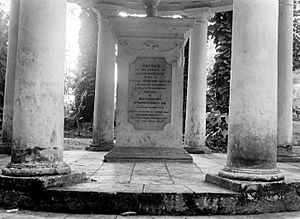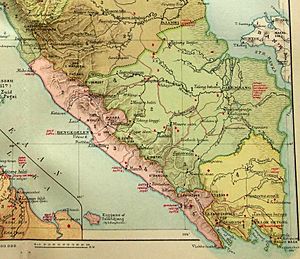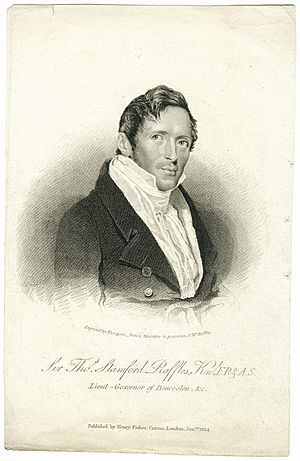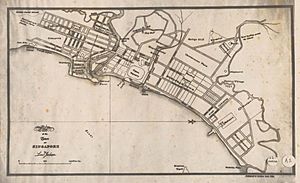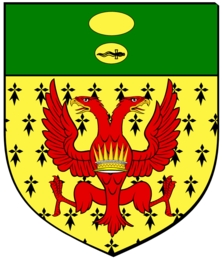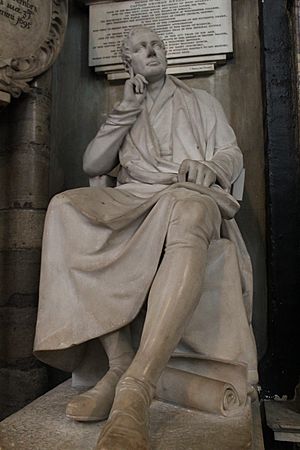Stamford Raffles facts for kids
Quick facts for kids
Stamford Raffles
|
|
|---|---|

Portrait by George Francis Joseph, c. 1817
|
|
| Lieutenant-Governor of Bencoolen | |
| In office 1818–1824 |
|
| Monarch | George III George IV |
| Preceded by | Office established |
| Succeeded by | Office abolished |
| Governors of the Dutch East Indies | |
| In office 1811–1816 |
|
| Appointed by | Earl of Minto |
| Monarch | George III |
| Preceded by | Robert Rollo Gillespie (acting) |
| Succeeded by | John Fendall Jr. |
| Personal details | |
| Born |
Thomas Stamford Bingley Raffles
5 July 1781 Onboard the ship Ann, off of the coast of Port Morant, Jamaica |
| Died | 5 July 1826 (aged 45) Highwood House, Highwood Hill, Middlesex, England |
| Cause of death | Brain Tumor |
| Resting place | St Mary's Church, Hendon, London, England |
| Nationality | British |
| Spouses |
Olivia Mariamne Devenish
(m. 1805; died 1814)Sophia Hull
(m. 1817) |
| Children | 5 |
| Parents |
|
| Education | Mansion House Boarding School |
| Known for | Founding of modern Singapore |
Sir Thomas Stamford Bingley Raffles (5 July 1781 – 5 July 1826) was a British official. He worked for the East India Company, a powerful trading company. He is most famous for helping to establish modern Singapore.
Raffles also played a big part in the British capture of Java (an Indonesian island) from the Dutch. This happened during the Napoleonic Wars. He also wrote a book called The History of Java.
Contents
- Stamford Raffles' Early Life
- Raffles and Java Island
- Time in England
- Bencoolen and Malaya
- Founding of Modern Singapore
- Raffles in Bencoolen Again
- Bencoolen Administration (1820–1822)
- Singapore (1822–1823)
- Return to Britain and Death
- Memorial Sculpture in Westminster Abbey
- Raffles' Legacy
- Images for kids
- See also
Stamford Raffles' Early Life
Thomas Stamford Bingley Raffles was born on July 5, 1781. He was born on a ship called Ann, near Jamaica. His father, Benjamin Raffles, was a ship captain. His mother was Anne Raffles.
His family faced money problems when his father stopped working in 1800. Young Raffles went to a boarding school called Mansion House Academy. It taught subjects like Latin, Greek, French, and math. This school helped boys prepare for jobs as clerks or in the army.
In 1795, at age 14, Raffles started working as a clerk. He worked for the British East India Company in London. This company was very important in Britain's overseas growth. In 1804, Raffles married Olivia Mariamne Devenish. She was a widow ten years older than him.
In 1805, he moved to Penang (now in Malaysia). This began his long connection with Southeast Asia. He started as an assistant secretary to the Governor of Penang. There, he met Thomas Otho Travers, who would be his companion for the next twenty years.
Raffles and Java Island
British Takeover of Java
Raffles was good at the Malay language. He was also very clever. This helped him gain favor with Lord Minto, the Governor-General of India. Lord Minto sent him to Malacca.
In 1811, France took over the Kingdom of Holland. This meant Raffles had to leave. He led a military mission against the Dutch and French in Java. The British army, led by Admiral Robert Stopford and General Frederick Augustus Wetherall, quickly won.
The previous Dutch Governor, Herman Willem Daendels, had built strong forts. His successor, Jan Willem Janssens, tried to defend them but failed. The British captured the main fort in just three hours. Governor Janssens was captured trying to escape.
The British took over Java in 45 days. Raffles was made the Lieutenant-Governor of the Dutch East Indies. He lived in Buitenzorg (now Bogor). He kept many Dutch officials in their government jobs.
Raffles' Rule in Java
During British rule in Java, Raffles made peace agreements. He also led military missions against local Javanese princes. This was to make them accept British rule. One important event was the attack on Yogyakarta in 1812. This was called the Sepoy Commotion.
Yogyakarta was one of the strongest local kingdoms in Java. During the attack, the Yogyakarta palace was badly damaged. British troops took many valuable items. This was a big event in Javanese history. It was the first time a local palace was taken by a European army.
Raffles also sent an expedition to Palembang in Sumatra. This was to remove the local sultan, Mahmud Badaruddin II. He also wanted to take Bangka Island. This would create a British base in case Java was returned to the Dutch.
Raffles tried to limit the local slave trade in Java. This was part of a wider British policy. He also tried to change the Dutch system of farming. He wanted a cash-based land management system instead.
Under Raffles, many ancient monuments in Java were studied. For example, Prambanan was described in detail. The Buddhist temple of Borobudur was cleared of plants and surveyed.
His wife, Olivia, died on November 26, 1814. This made Raffles very sad. In 1815, he went back to England. Java was returned to the Netherlands after the Napoleonic Wars. Raffles was removed from his job before this happened. There were concerns about the colony's finances under his rule. He sailed to England in early 1816 to clear his name.
Time in England
In 1817, Raffles published his book, The History of Java. It described the island's history, geography, plants, and animals.
In 1817, Raffles was made a Knight Bachelor by Prince Regent, George IV. He also started using his middle name, 'Stamford', instead of 'Thomas'. On February 22, he married his second wife, Sophia Hull. Then, he sailed to Bencoolen (now Bengkulu in Indonesia) for a new job.
Bencoolen and Malaya
Raffles arrived in Bencoolen on March 19, 1818. He was appointed as the Lieutenant-Governor of Bencoolen. Bencoolen was not a very important colony. Its main export was pepper. Raffles found the place in bad shape. He immediately started reforms, similar to what he did in Java. He worked to end slavery and limit activities like cockfighting. He used convicts from India to replace the enslaved people.
Raffles realized Britain needed a strong presence in the area. This would challenge Dutch power and be profitable. He looked at other islands like Bangka and Bintan. The Riau Archipelago was also a good choice because it was close to Malacca.
Raffles also stressed the need to work with local chiefs. He sent Thomas Travers to negotiate with the Dutch. When this failed, Raffles became even more determined to establish a better British presence. He even led a small group to the Sultanate of Minangkabau to confirm British influence there.
Founding of Modern Singapore
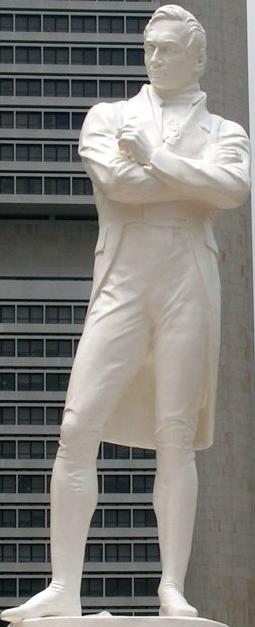
Major-General William Farquhar, a British official in Malacca, had been trying to make trade deals with local chiefs. Raffles sailed to Malacca in late 1818. He wanted to find a British base in the Riau area, especially Singapura (Singapore). He had read about its importance in Malay history.
Even though Lord Hastings had not thought highly of Raffles before, Raffles was now well-connected. He got permission to set up a settlement. Singapore was in a very good location for trade. However, he was told not to upset the Dutch.
In London, British officials tried to calm Dutch concerns. They worked on an agreement that became the Anglo-Dutch Treaty of 1824. Orders were sent to Raffles to be less forceful. But the distance meant the orders did not reach him in time.
Establishing Singapore
After looking at the Karimun Islands, Raffles set up a post on January 29, 1819. This was at the southern tip of the Malay Peninsula. There were no Dutch on the island of Singapore. The local ruler, Temenggong Abdul Rahman, was friendly. Raffles used the unclear political situation to make a basic agreement. This agreement gave Britain exclusive trading rights and protection for the area.
A few days later, a formal treaty was signed. It was signed by Hussein Shah, who claimed to be the rightful ruler of the region. Hussein Shah was the crown prince of Johor. But his younger brother became sultan with Dutch support. Raffles recognized Hussein Shah as the true ruler of Johor. This allowed him to make a deal without Dutch influence.
Raffles officially declared the founding of modern Singapore on February 6, 1819. This secured the island for the East India Company. The treaty was read aloud in many languages. Sultan Hussein Shah and Temenggong Abdul Rahman received large yearly payments.
Farquhar was named the Resident of Singapore. Raffles was named 'Agent to the Governor-General'. The British wanted free passage for ships through the Singapore Strait. A small military base was also set up. Raffles left Singapore the next day, February 7, 1819.
Early Conflicts with the Dutch
Raffles also planned a British presence in Aceh (northern Sumatra). The Dutch were upset about Singapore. They ordered that no Malays could go to Singapore. Raffles tried to calm the situation. He told Farquhar not to interfere with local politics.
Despite Dutch threats, they did not take military action. The political situation in Johore and Rhio was confusing. This made things unstable for both nations. Raffles landed in Achin on March 14, 1819. He signed a treaty with Jauhar al-Alam Shah, the ruler of Achin. This treaty set up a British Resident and ensured exclusive trade.
By the time Raffles returned to Singapore on May 31, the crisis had passed. The small village had grown to five thousand people. Raffles wanted to break the Dutch trading control. He wanted Singapore to be a gateway for trade with China and Japan.
Singapore's First Year
In Singapore, Raffles started schools and churches. He allowed missionaries and local businesses to grow. A European town was built, separated by a river. Roads and military camps were also built. No other taxes were put in place.
Raffles was confident that Farquhar would follow his orders. He sailed back to Bencoolen on June 28.
Raffles in Bencoolen Again
Raffles was still the Lieutenant-Governor of Bencoolen. He started more reforms. He ended forced labor and made Bencoolen a free port. He also regulated the currency. He used his many civil servants to form committees to help run the colony.
Bencoolen was not as successful as Singapore. It was poor and had many diseases. Raffles focused on farming the available land. Local leaders were given power in their areas. Raffles also brought in a "slave-debtor system" to replace the old slavery system. Educational reforms focused on children. Raffles had a long-term plan for Bencoolen's slow improvement.
Unlike many other European leaders, Raffles did not force his language or culture on the people. He worked to preserve local artifacts, animals, and plants. He also allowed religious freedom. This was important because many Malay states were Muslim. Christian schools were started by missionaries in his colonies.
Expanding British Influence
When Colonel Bannerman died in Penang in October 1819, Raffles saw a chance to expand British power. He sailed to Calcutta. Lord Hastings wanted to combine all small British areas in the East Indies. Raffles argued for free trade and private business. Education and keeping small British outposts were also discussed.
The Dutch still claimed the Sultanate of Johore. Discussions between the Dutch and Calcutta continued. The British treaties were questioned. But as Singapore grew quickly, the Dutch gave up their claim on the island. Singapore remained a British possession. Raffles, whose health was getting worse, returned to Bencoolen.
Bencoolen Administration (1820–1822)
Raffles returned to Bencoolen in poor health. As he got better, he continued to learn about the island. He studied the Batak people and their customs. He also noticed the rise of the Sikh religion in parts of Sumatra.
By early 1820, Tengku Long was recognized as the Sultan of Johor by the British. But the political situation remained messy. Farquhar was not handling local politics well. Raffles appointed Travers as the new Resident of Singapore, replacing Farquhar. Travers found Singapore to be a busy mix of different cultures, with over six thousand people. Singapore's trade was even starting to surpass Java's.
Like in Java, Raffles collected plant and animal samples. He described them in his journals. He also found other tribes and recorded their customs and religions. He brought the island of Nias under British rule. He noted its good farming and high rice production.
However, food production was still a problem. In Bencoolen, Raffles focused on Chinese farming methods. His employer, the East India Company, was only concerned with making money. They did not like his spending on nature preservation. Both Calcutta and London discussed removing him from office.
The Singapore issue had supporters in the British Parliament. So, Raffles remained in Bencoolen. The main problem was Farquhar, who did not want to leave his post. Raffles sent Travers to India, which solved the issue for a while. Farquhar remained in charge of Singapore. Many in India and London still doubted Singapore's future. Farquhar also caused problems with local English merchants. Public works ordered by Raffles but done by Farquhar became very expensive.
Raffles also faced personal sadness. His oldest son, Leopold Stamford, died on July 4, 1821, during an epidemic. His youngest son, Stamford Marsden, died on January 3, 1822. His oldest daughter, Charlotte, died ten days later. Raffles and his wife were devastated for months. Feeling restless, Raffles decided to visit Singapore before going home to England. His wife Sophia and their only surviving child, Ella, went with him.
Raffles was elected a member of the American Antiquarian Society (AAS) in 1822.
Singapore (1822–1823)
Raffles returned to Singapore in October 1822. He was happy that Singapore had grown so much. It was a busy center for trade. However, he found Farquhar's management unsatisfactory. Farquhar had allowed merchants to build on government land. He also allowed activities like gambling and slavery.
Raffles put new rules in place. He set up a committee led by Philip Jackson to create a town plan. This plan, known as the Jackson Plan, divided the population by race. Europeans got the best land. But it was still considered very scientific for its time. Raffles also oversaw the leveling of a small hill to create Commercial Square (now Raffles Place).
Farquhar and Raffles had a big argument. Raffles thought Farquhar was not fit for his job. Raffles dismissed Farquhar in April 1823 and took direct control. He had written to Calcutta in January 1823, saying Farquhar was not good at his job. Raffles made Johor a British protectorate. This caused a protest from the Dutch Governor-General. Eventually, Calcutta appointed John Crawfurd as the new Resident of Singapore.
On April 1, 1823, Raffles held a meeting to open a Malay college in Singapore. He believed in the importance of both local and European languages. Raffles personally gave $2,000 for the college. The East India Company gave $4,000. This led to the founding of Raffles Institution.
In his last weeks in Singapore in 1823, Raffles wrote new rules for the city. These rules aimed to govern Singapore fairly. They also showed his views on moral and social issues. A system was set up to register all land. If land was not registered, the government could take it back. This showed the power of the British government. Laws were also made for the port and free trade. In May 1823, he banned gambling. He also put high taxes on alcohol and banned slavery. A police force and court system were also set up. This helped turn the trading post into an organized city.
Finally, on June 9, 1823, Raffles felt his work in Singapore was done. He boarded a ship for England. He stopped in Batavia to visit his old home and meet the Dutch Governor-General. He then made a final stop in Bencoolen. Sadly, his youngest daughter, Flora Nightingall, died in Bencoolen on November 28.
On February 2, 1824, Raffles and his family sailed for England on the ship Fame. The ship caught fire about 50 miles from Bencoolen. Everyone got into boats and was saved. But the ship and all his drawings and papers were destroyed.
The Anglo-Dutch Treaty of 1824 finally settled the control of the East Indies. The British controlled the north, and Sumatra became Dutch. The Malay Peninsula and India were free of Dutch interference. Raffles finally returned to England on August 22, 1824. His longest time in Singapore was only eight months. But he is still known as the founder of Singapore.
Return to Britain and Death
When he arrived in England, Sir Stamford and Lady Raffles were in poor health. They rested in Cheltenham. Then, Raffles hosted important guests in London and at his home. He also planned to run for parliament, but this never happened. In November 1824, they moved to London. There, Raffles had a disagreement with Farquhar in front of the East India Company. Farquhar made several serious accusations against Raffles. But he could not prove them. Farquhar was not given his job back in Singapore, but he did get a military promotion.
With the Singapore matter settled, Raffles focused on his other interests: botany (plants) and zoology (animals). He became a member of the Linnean Society of London in 1825. Raffles also helped start the Zoological Society of London (ZSL) in 1825. He was elected its first president in April 1826.
Raffles was not given a pension. Instead, he was asked to pay over twenty-two thousand pounds for losses during his time in charge. Raffles explained his actions. He moved to his country home, Highwood, in North London. But he became too ill before the issue was resolved.
He died at Highwood House in Mill Hill, north London, on his 45th birthday, July 5, 1826. He died from a stroke. His money went to the East India Company to cover his debt. Because he was against slavery, the local church refused to bury him inside. This was because the vicar's family had made money from the slave trade. A tablet was placed in the church in 1887. But his body was not found until 1914. When the church was expanded in the 1920s, his tomb became part of the building.
Raffles was survived by his second wife, Sophia Hull, and their daughter, Ella. His other four children had died in Bencoolen. Ella died in 1840 at age nineteen. Sophia lived at Highwood House until she died in 1858. Thirty-three years after Raffles's death, his large collection of Indonesian items was given to the British Museum by his nephew.
Memorial Sculpture in Westminster Abbey
There is a white marble statue of Raffles in Westminster Abbey, London. It was made by Sir Francis Leggatt Chantrey in 1832. The statue shows Raffles sitting down. It is in the north choir aisle of the Abbey.
Raffles' Legacy
Many things in Singapore and other parts of the world are named after Stamford Raffles.
Natural History and Species Named After Raffles
- Raffles gave the scientific name to the crab-eating macaque (Macaca fascicularis).
- He also named the lesser mouse-deer (Tragulus kanchil).
Many other species are named after him:
- Chaetodon rafflesii, a type of butterflyfish
- Dinopium rafflesii, an olive-backed woodpecker
- Megalaima rafflesi, a red-crowned barbet
- Nepenthes rafflesiana, a type of pitcher plant
- Protanilla rafflesi Taylor, 1990, a type of ant
- Rafflesia, a group of parasitic flowering plants known for having the world's largest flowers
- Theridion rafflesi Simon, 1899, a spider from Sumatra
While in Sumatra, Raffles hired artists to draw his collections of animals and plants. These drawings are now kept at the British Library.
Places and Landmarks Named After Raffles
- Raffles City
- Raffles Hospital
- Raffles Hotel
- Raffles Museum of Biodiversity Research
- Raffles Place
Businesses Named After Raffles
- Raffles Holdings
- Raffles Medical Group
- Yantai Raffles Shipyard
Education Institutions Named After Raffles
- Raffles College – now part of the National University of Singapore (NUS)
- Raffles Girls' Primary School
- Raffles Girls' School (Secondary)
- Raffles Institution (Secondary and Junior College)
- Stamford Primary School, formerly Stamford Girls' School
- Stamford American International School
Sports and Recreation Named After Raffles
- Raffles Cup
Transport and Infrastructure Named After Raffles
- Raffles Institution Lane
- Raffles Lighthouse
- Raffles Place MRT station
- Stamford Road
- Raffles Class – The former name for Singapore Airlines Business Class
There are two statues of Sir Stamford Raffles in Singapore. One is made of white marble and is along the Singapore River. The other is made of bronze and is in front of the Victoria Theatre and Concert Hall.
Images for kids
-
Fragrant nutmeg (Myristica fragrans)
-
Durian (Durio zibethinus)
-
Oriental bay owl (Phodilus badius)
-
Malay apple (Syzygium malaccense)
-
Langsat (Lansium parasiticum)
-
Otter civet (Cynogale bennettii)
See also
 In Spanish: Thomas Stamford Raffles para niños
In Spanish: Thomas Stamford Raffles para niños
- History of Singapore
- Raffles's Landing Site


